Case Study of Tesco: HR Strategies and Employee Motivation Theories
VerifiedAdded on 2023/06/07
|5
|1244
|169
Case Study
AI Summary
This case study examines the role of Human Resources (HR) in motivating employees, focusing on Tesco as a research organization. It defines motivation and its importance, explaining motivational theories such as Maslow's Hierarchy of Needs and Herzberg's Two-Factor Theory. The study details how Tesco applies these theories by addressing employees' physiological and security needs, offering opportunities for self-actualization through performance appraisals, and focusing on both hygiene and motivating factors. Key steps Tesco uses include valuing employees, regular communication, implementing motivational theories, providing training and development, and offering rewards. The conclusion emphasizes the crucial role of HR in motivating staff and highlights the specific strategies Tesco employs to foster a motivated workforce.
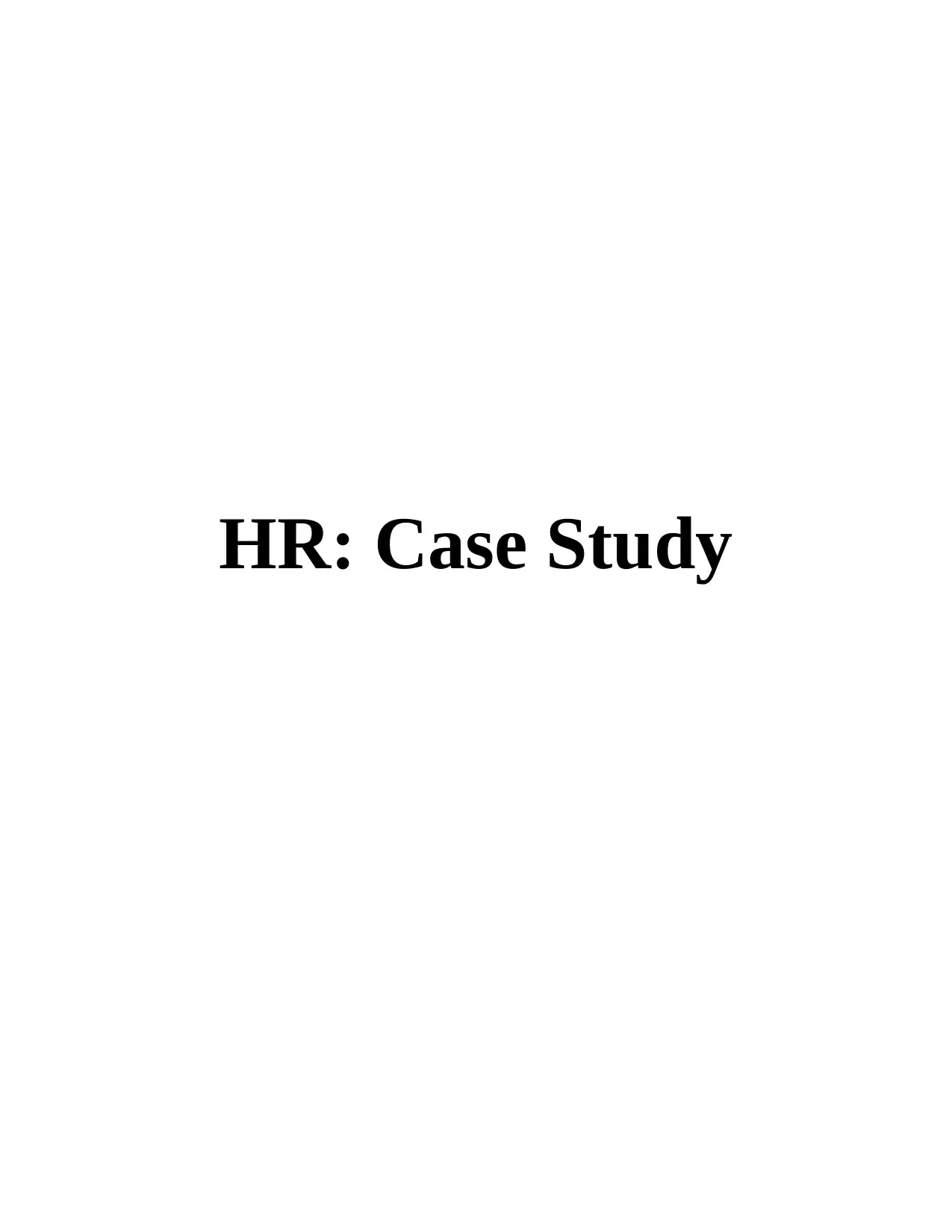
HR: Case Study
Paraphrase This Document
Need a fresh take? Get an instant paraphrase of this document with our AI Paraphraser
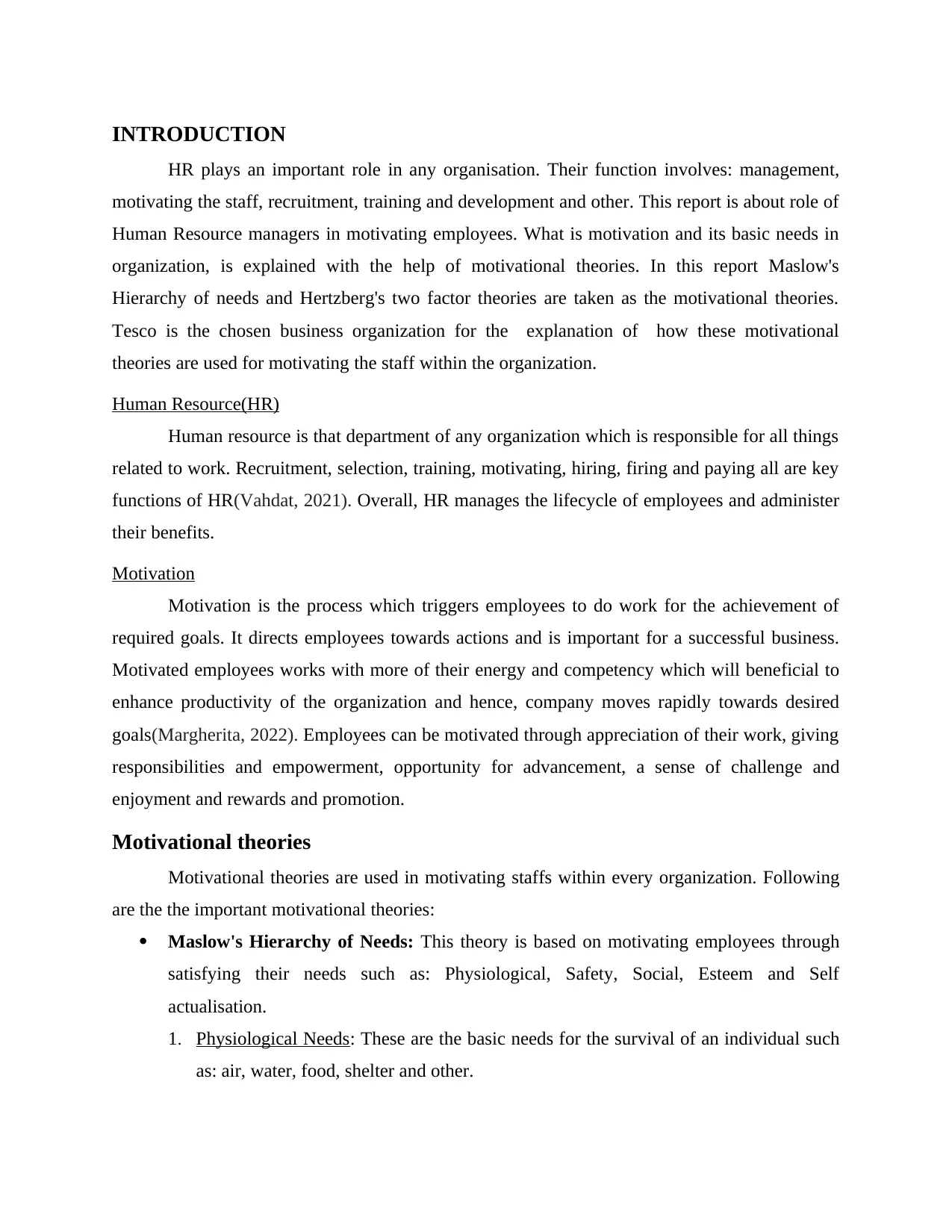
INTRODUCTION
HR plays an important role in any organisation. Their function involves: management,
motivating the staff, recruitment, training and development and other. This report is about role of
Human Resource managers in motivating employees. What is motivation and its basic needs in
organization, is explained with the help of motivational theories. In this report Maslow's
Hierarchy of needs and Hertzberg's two factor theories are taken as the motivational theories.
Tesco is the chosen business organization for the explanation of how these motivational
theories are used for motivating the staff within the organization.
Human Resource(HR)
Human resource is that department of any organization which is responsible for all things
related to work. Recruitment, selection, training, motivating, hiring, firing and paying all are key
functions of HR(Vahdat, 2021). Overall, HR manages the lifecycle of employees and administer
their benefits.
Motivation
Motivation is the process which triggers employees to do work for the achievement of
required goals. It directs employees towards actions and is important for a successful business.
Motivated employees works with more of their energy and competency which will beneficial to
enhance productivity of the organization and hence, company moves rapidly towards desired
goals(Margherita, 2022). Employees can be motivated through appreciation of their work, giving
responsibilities and empowerment, opportunity for advancement, a sense of challenge and
enjoyment and rewards and promotion.
Motivational theories
Motivational theories are used in motivating staffs within every organization. Following
are the the important motivational theories:
Maslow's Hierarchy of Needs: This theory is based on motivating employees through
satisfying their needs such as: Physiological, Safety, Social, Esteem and Self
actualisation.
1. Physiological Needs: These are the basic needs for the survival of an individual such
as: air, water, food, shelter and other.
HR plays an important role in any organisation. Their function involves: management,
motivating the staff, recruitment, training and development and other. This report is about role of
Human Resource managers in motivating employees. What is motivation and its basic needs in
organization, is explained with the help of motivational theories. In this report Maslow's
Hierarchy of needs and Hertzberg's two factor theories are taken as the motivational theories.
Tesco is the chosen business organization for the explanation of how these motivational
theories are used for motivating the staff within the organization.
Human Resource(HR)
Human resource is that department of any organization which is responsible for all things
related to work. Recruitment, selection, training, motivating, hiring, firing and paying all are key
functions of HR(Vahdat, 2021). Overall, HR manages the lifecycle of employees and administer
their benefits.
Motivation
Motivation is the process which triggers employees to do work for the achievement of
required goals. It directs employees towards actions and is important for a successful business.
Motivated employees works with more of their energy and competency which will beneficial to
enhance productivity of the organization and hence, company moves rapidly towards desired
goals(Margherita, 2022). Employees can be motivated through appreciation of their work, giving
responsibilities and empowerment, opportunity for advancement, a sense of challenge and
enjoyment and rewards and promotion.
Motivational theories
Motivational theories are used in motivating staffs within every organization. Following
are the the important motivational theories:
Maslow's Hierarchy of Needs: This theory is based on motivating employees through
satisfying their needs such as: Physiological, Safety, Social, Esteem and Self
actualisation.
1. Physiological Needs: These are the basic needs for the survival of an individual such
as: air, water, food, shelter and other.
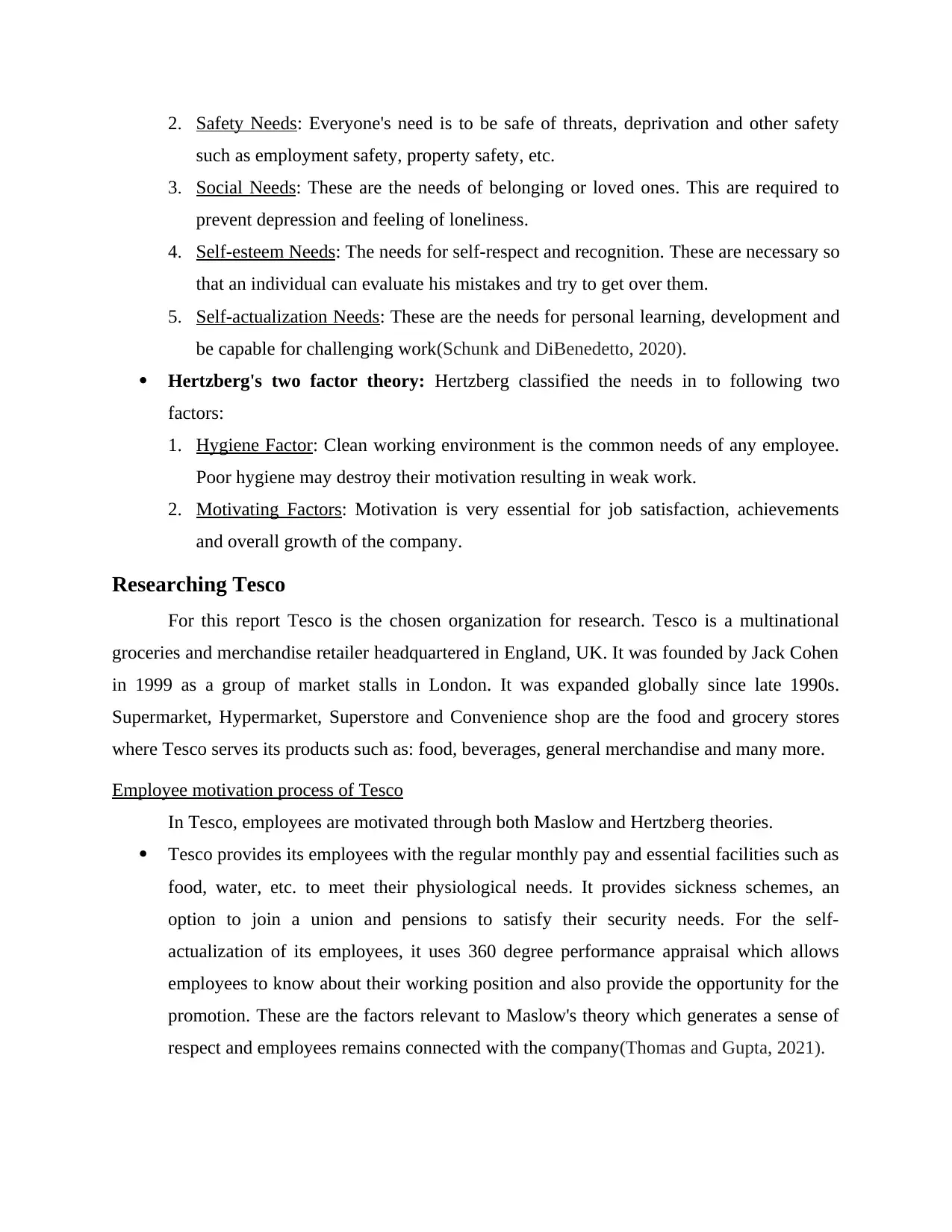
2. Safety Needs: Everyone's need is to be safe of threats, deprivation and other safety
such as employment safety, property safety, etc.
3. Social Needs: These are the needs of belonging or loved ones. This are required to
prevent depression and feeling of loneliness.
4. Self-esteem Needs: The needs for self-respect and recognition. These are necessary so
that an individual can evaluate his mistakes and try to get over them.
5. Self-actualization Needs: These are the needs for personal learning, development and
be capable for challenging work(Schunk and DiBenedetto, 2020).
Hertzberg's two factor theory: Hertzberg classified the needs in to following two
factors:
1. Hygiene Factor: Clean working environment is the common needs of any employee.
Poor hygiene may destroy their motivation resulting in weak work.
2. Motivating Factors: Motivation is very essential for job satisfaction, achievements
and overall growth of the company.
Researching Tesco
For this report Tesco is the chosen organization for research. Tesco is a multinational
groceries and merchandise retailer headquartered in England, UK. It was founded by Jack Cohen
in 1999 as a group of market stalls in London. It was expanded globally since late 1990s.
Supermarket, Hypermarket, Superstore and Convenience shop are the food and grocery stores
where Tesco serves its products such as: food, beverages, general merchandise and many more.
Employee motivation process of Tesco
In Tesco, employees are motivated through both Maslow and Hertzberg theories.
Tesco provides its employees with the regular monthly pay and essential facilities such as
food, water, etc. to meet their physiological needs. It provides sickness schemes, an
option to join a union and pensions to satisfy their security needs. For the self-
actualization of its employees, it uses 360 degree performance appraisal which allows
employees to know about their working position and also provide the opportunity for the
promotion. These are the factors relevant to Maslow's theory which generates a sense of
respect and employees remains connected with the company(Thomas and Gupta, 2021).
such as employment safety, property safety, etc.
3. Social Needs: These are the needs of belonging or loved ones. This are required to
prevent depression and feeling of loneliness.
4. Self-esteem Needs: The needs for self-respect and recognition. These are necessary so
that an individual can evaluate his mistakes and try to get over them.
5. Self-actualization Needs: These are the needs for personal learning, development and
be capable for challenging work(Schunk and DiBenedetto, 2020).
Hertzberg's two factor theory: Hertzberg classified the needs in to following two
factors:
1. Hygiene Factor: Clean working environment is the common needs of any employee.
Poor hygiene may destroy their motivation resulting in weak work.
2. Motivating Factors: Motivation is very essential for job satisfaction, achievements
and overall growth of the company.
Researching Tesco
For this report Tesco is the chosen organization for research. Tesco is a multinational
groceries and merchandise retailer headquartered in England, UK. It was founded by Jack Cohen
in 1999 as a group of market stalls in London. It was expanded globally since late 1990s.
Supermarket, Hypermarket, Superstore and Convenience shop are the food and grocery stores
where Tesco serves its products such as: food, beverages, general merchandise and many more.
Employee motivation process of Tesco
In Tesco, employees are motivated through both Maslow and Hertzberg theories.
Tesco provides its employees with the regular monthly pay and essential facilities such as
food, water, etc. to meet their physiological needs. It provides sickness schemes, an
option to join a union and pensions to satisfy their security needs. For the self-
actualization of its employees, it uses 360 degree performance appraisal which allows
employees to know about their working position and also provide the opportunity for the
promotion. These are the factors relevant to Maslow's theory which generates a sense of
respect and employees remains connected with the company(Thomas and Gupta, 2021).
⊘ This is a preview!⊘
Do you want full access?
Subscribe today to unlock all pages.

Trusted by 1+ million students worldwide
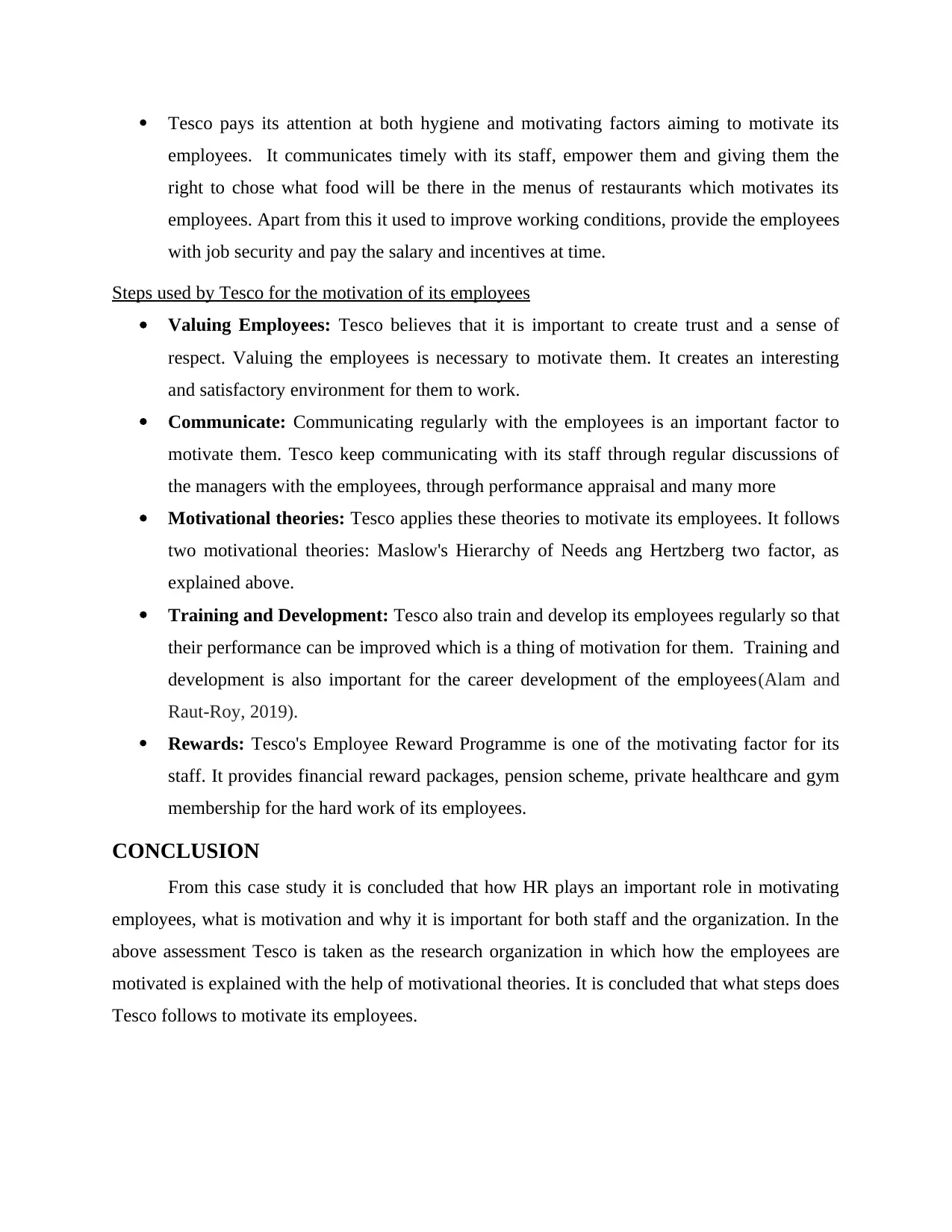
Tesco pays its attention at both hygiene and motivating factors aiming to motivate its
employees. It communicates timely with its staff, empower them and giving them the
right to chose what food will be there in the menus of restaurants which motivates its
employees. Apart from this it used to improve working conditions, provide the employees
with job security and pay the salary and incentives at time.
Steps used by Tesco for the motivation of its employees
Valuing Employees: Tesco believes that it is important to create trust and a sense of
respect. Valuing the employees is necessary to motivate them. It creates an interesting
and satisfactory environment for them to work.
Communicate: Communicating regularly with the employees is an important factor to
motivate them. Tesco keep communicating with its staff through regular discussions of
the managers with the employees, through performance appraisal and many more
Motivational theories: Tesco applies these theories to motivate its employees. It follows
two motivational theories: Maslow's Hierarchy of Needs ang Hertzberg two factor, as
explained above.
Training and Development: Tesco also train and develop its employees regularly so that
their performance can be improved which is a thing of motivation for them. Training and
development is also important for the career development of the employees(Alam and
Raut-Roy, 2019).
Rewards: Tesco's Employee Reward Programme is one of the motivating factor for its
staff. It provides financial reward packages, pension scheme, private healthcare and gym
membership for the hard work of its employees.
CONCLUSION
From this case study it is concluded that how HR plays an important role in motivating
employees, what is motivation and why it is important for both staff and the organization. In the
above assessment Tesco is taken as the research organization in which how the employees are
motivated is explained with the help of motivational theories. It is concluded that what steps does
Tesco follows to motivate its employees.
employees. It communicates timely with its staff, empower them and giving them the
right to chose what food will be there in the menus of restaurants which motivates its
employees. Apart from this it used to improve working conditions, provide the employees
with job security and pay the salary and incentives at time.
Steps used by Tesco for the motivation of its employees
Valuing Employees: Tesco believes that it is important to create trust and a sense of
respect. Valuing the employees is necessary to motivate them. It creates an interesting
and satisfactory environment for them to work.
Communicate: Communicating regularly with the employees is an important factor to
motivate them. Tesco keep communicating with its staff through regular discussions of
the managers with the employees, through performance appraisal and many more
Motivational theories: Tesco applies these theories to motivate its employees. It follows
two motivational theories: Maslow's Hierarchy of Needs ang Hertzberg two factor, as
explained above.
Training and Development: Tesco also train and develop its employees regularly so that
their performance can be improved which is a thing of motivation for them. Training and
development is also important for the career development of the employees(Alam and
Raut-Roy, 2019).
Rewards: Tesco's Employee Reward Programme is one of the motivating factor for its
staff. It provides financial reward packages, pension scheme, private healthcare and gym
membership for the hard work of its employees.
CONCLUSION
From this case study it is concluded that how HR plays an important role in motivating
employees, what is motivation and why it is important for both staff and the organization. In the
above assessment Tesco is taken as the research organization in which how the employees are
motivated is explained with the help of motivational theories. It is concluded that what steps does
Tesco follows to motivate its employees.
Paraphrase This Document
Need a fresh take? Get an instant paraphrase of this document with our AI Paraphraser
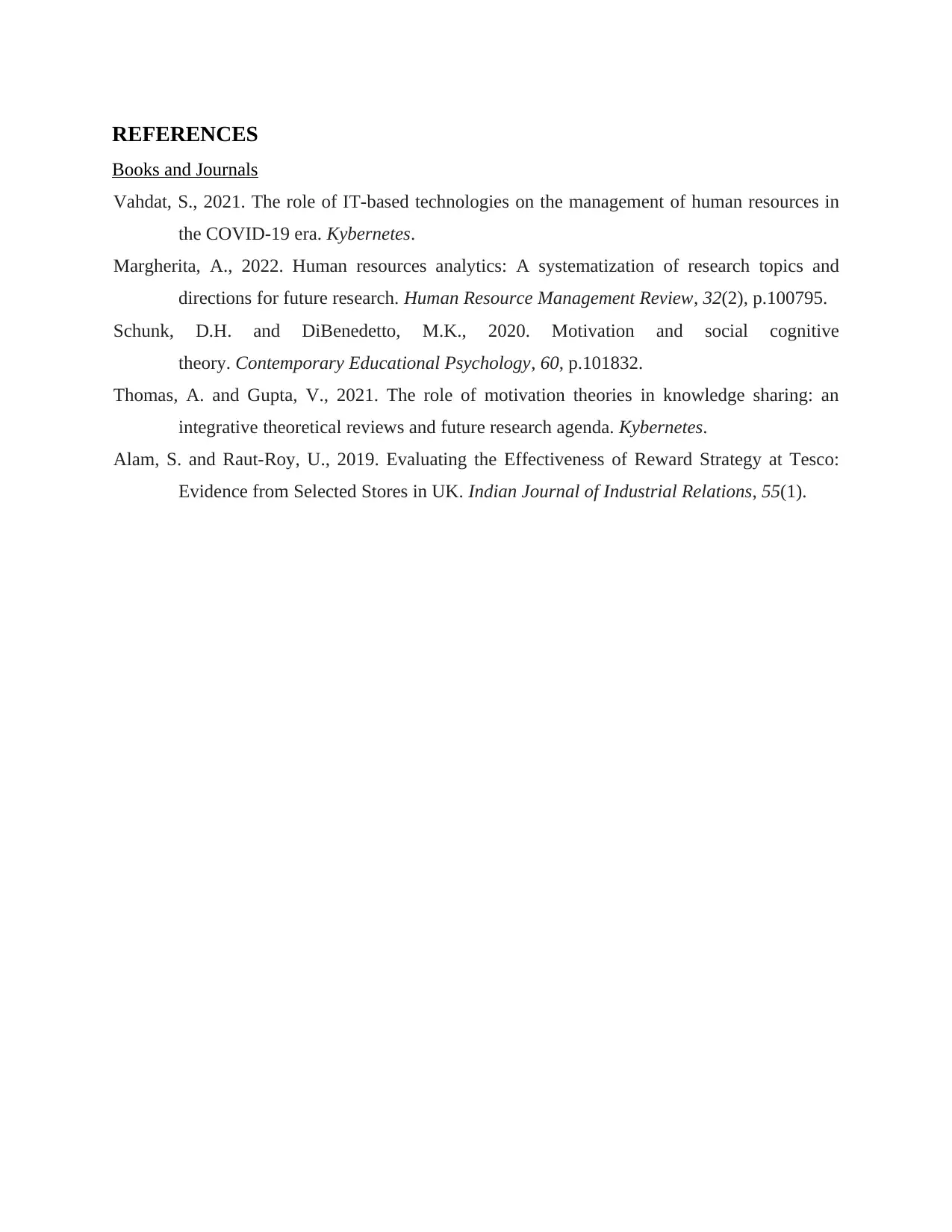
REFERENCES
Books and Journals
Vahdat, S., 2021. The role of IT-based technologies on the management of human resources in
the COVID-19 era. Kybernetes.
Margherita, A., 2022. Human resources analytics: A systematization of research topics and
directions for future research. Human Resource Management Review, 32(2), p.100795.
Schunk, D.H. and DiBenedetto, M.K., 2020. Motivation and social cognitive
theory. Contemporary Educational Psychology, 60, p.101832.
Thomas, A. and Gupta, V., 2021. The role of motivation theories in knowledge sharing: an
integrative theoretical reviews and future research agenda. Kybernetes.
Alam, S. and Raut-Roy, U., 2019. Evaluating the Effectiveness of Reward Strategy at Tesco:
Evidence from Selected Stores in UK. Indian Journal of Industrial Relations, 55(1).
Books and Journals
Vahdat, S., 2021. The role of IT-based technologies on the management of human resources in
the COVID-19 era. Kybernetes.
Margherita, A., 2022. Human resources analytics: A systematization of research topics and
directions for future research. Human Resource Management Review, 32(2), p.100795.
Schunk, D.H. and DiBenedetto, M.K., 2020. Motivation and social cognitive
theory. Contemporary Educational Psychology, 60, p.101832.
Thomas, A. and Gupta, V., 2021. The role of motivation theories in knowledge sharing: an
integrative theoretical reviews and future research agenda. Kybernetes.
Alam, S. and Raut-Roy, U., 2019. Evaluating the Effectiveness of Reward Strategy at Tesco:
Evidence from Selected Stores in UK. Indian Journal of Industrial Relations, 55(1).
1 out of 5
Related Documents
Your All-in-One AI-Powered Toolkit for Academic Success.
+13062052269
info@desklib.com
Available 24*7 on WhatsApp / Email
![[object Object]](/_next/static/media/star-bottom.7253800d.svg)
Unlock your academic potential
Copyright © 2020–2025 A2Z Services. All Rights Reserved. Developed and managed by ZUCOL.




